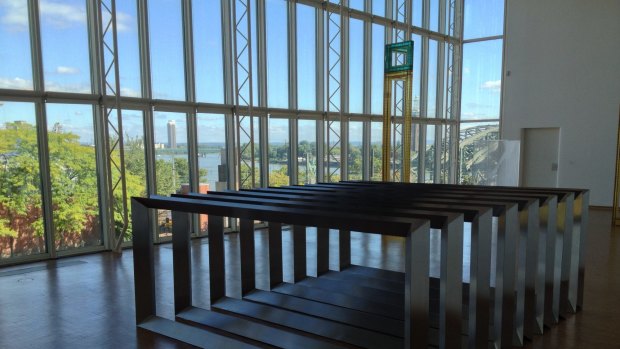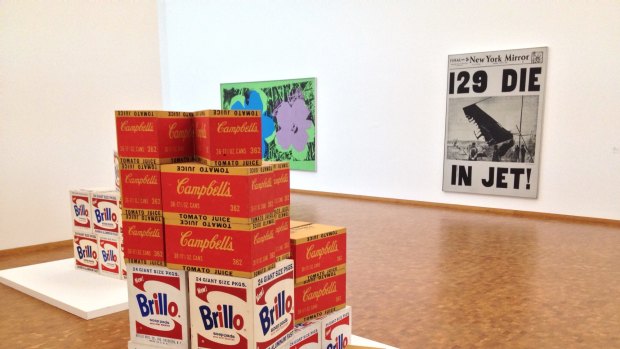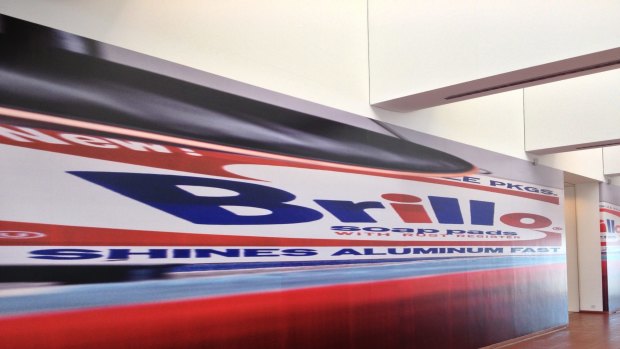This was published 9 years ago
Cologne's travel bookends combine pop art museum and city's other treasures
Cologne goes Pop,Tim Richards says.
By Tim Richards

Museum Ludwig in Koln.
On the top floor of Cologne's Museum Ludwig, I discover a little secret. If you push through the glass doors next to the loos on this level, you end up on an empty brick-paved terrace with an excellent view of Cologne Cathedral.
Somehow this seems fitting. The vast medieval cathedral is the city's pride and joy, and Germany's most visited attraction; while the museum houses an extensive modern art collection. Together they neatly bookend the city's art history, from the 13th century to the present day.

Museum Ludwig in Koln.
For a lover of 20th century art, Museum Ludwig is a worthy object of pilgrimage. Founded in 1976 by local art collectors Peter and Irene Ludwig, the museum received significant donations of Russian avant-garde works, along with an impressive collection of Expressionist art which had eluded the critical Nazi authorities during World War II.
The collection was bolstered by a hefty donation of Picasso works over the years, and the museum now has one of the largest Picasso collections in the world.
All these are reason enough to visit, but I'm particularly interested in its American Pop Art collection, the largest outside the US. I'm a great fan of the movement but have never seen much of it in one place.

Museum Ludwig in Koln.
That's not a problem here. Past a huge distorted photo of one of Andy Warhol's artistically recreated Brillo boxes, I'm face to face with Warhol's hand-painted sheet of $2 banknotes.
Beyond this is plenty more from the legendary New York artist, including his overlapping photos of Elvis Presley, multiple shots of a race riot shaded in pink, and a big re-creation of a newspaper front page story about an air crash. There are also several of his actual Brillo boxes, stacked decoratively on a platform.
Seeing all this work together reminds me how diverse Warhol was as an artist - he didn't just turn out paintings of tomato soup cans.
I'm also impressed by the museum's interior. Not only is it relatively peaceful on a weekday morning but there's lots of space, with natural light courtesy of lofty ceilings with strategically placed skylights.
Another pop art star on display is Roy Lichtenstein, famous for playing around with the comic strip in his big colourful works. In one work here, Mad Scientist, he depicted a ranting supervillain about to unleash his fiendish plan; and in another he created a nautical-themed still life made up of dots, as if reproduced on newsprint.
My favourite Lichtenstein in the collection is Explosion No 1, a vivid cartoonish representation of an explosion. In red, white and yellow, its three-dimensional burst somehow looks both static and dynamic, and says everything you need to know about the pop artist's ability to rework images from popular culture.
I pass the work of other pop art greats such as Jasper Johns and Robert Rauschenberg, but the next big star of the museum is Marcel Duchamp. A conceptual artist from an earlier era, he revolutionised the art world through his use of "readymades", everyday items reimagined as art.
I've seen his famous Bicycle Wheel, a wheel turned upside down on a stool, in art documentaries. There's a copy of the work here, looking just as absurd and brilliant in its simplicity. I can't help thinking that Warhol must have appreciated Duchamp's use of everyday objects to make a point.
Not that the Museum Ludwig is all about the past. Each year it awards the Wolfgang Hahn Prize to an international contemporary artist, and there's a selection of their work on display. There's some great art here, but I'm particularly drawn to Donald Judd's huge unnamed piece, a set of eight identical steel frames placed in parallel.
I like it partly because I like abstract art, but also because the museum has cannily placed it in a light-filled room with floor to ceiling windows. Looking through the art to the outside world, I have my first glimpse of the River Rhine.
There's plenty more to see in the museum, including Picasso's Cubist creations, various Expressionist works, and lots of surrealist art created by the likes of Miró and Magritte.
With the architecture artfully showing off the diverse collection to its best effect, I don't think I've ever enjoyed walking through an gallery as much as I have here. It's been a crash course in modern art, and I'm glad I signed up.
Tim Richards travelled courtesy of Railbookers Australia.
THE FACTS
FLY
Emirates (emirates.com) and its partners fly to Cologne via Dubai and Munich, from $2500 return.
Alternatively, Railbookers (railbookers.com.au) can arrange a rail itinerary to Cologne from numerous European cities.
STAY
Hotel Mondial Am Dom, Kurt Hackenberg Platz 1, Cologne, mgallery.com.
Pension Otto, Richard Wagner Strasse 18, Cologne, pensionotto.de.
SEE
Museum Ludwig, Heinrich Böll Platz, Cologne, museum-ludwig.de. Open 10am-6pm Tuesday to Sunday, admission €11 ($16).
Sign up for the Traveller Deals newsletter
Get exclusive travel deals delivered straight to your inbox. Sign up now.